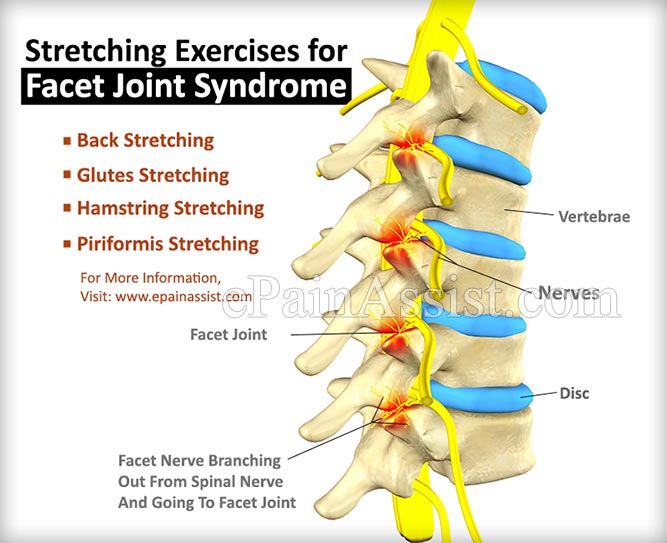Facet joint syndrome is predominantly caused by aging process; excessive pressure over the facets; or traumatic injury. Excess pressure build up over the facet is generally caused due to degenerative changes in the intervertebral discs. This over a period of time leads to wearing down of the joints and they begin to collapse. Facet joint syndrome is a commonly experienced condition which is often very painful. However, with regular practice of certain stretching exercises, one can easily control worsening of facet joint syndrome.

Stretching Exercises for Facet Joint Syndrome
In most of the cases, exercises are recommended along with conservative measures for management of facet joint syndrome. The recommended exercises for facet joint syndrome include aerobics, stretching and strengthening exercise. Postural exercises are beneficial for alignment of spine and for decreasing the pressure built up of the spine.
Some of the Stretching Exercises for Facet Joint Syndrome Include:
Back Stretching Exercise for Facet Joint Syndrome:
To do this exercise for Facet Joint Syndrome, one should lie on his or her back with legs straight and back of the head rested on the floor. This is followed by pulling the knees to the chest, lifting head off the floor and dropping chin to the chest. Tilting of head forward helps in lengthening the spine from above. Lifting the knees helps in lengthening the lumbar spine and thus gives a good stretch to the facet joints. Hold the posture for 15 seconds and return to the normal resting state. Repeat the exercise for 5 times.
Glutes Stretching Exercise for Facet Joint Syndrome:
The gluteus muscles or the muscles of the buttocks are connected to the pelvis. They pull on the lower portion of the lower back when tight. To stretch the gluteus, it is advised to lie face down and bend right leg up below the abdomen. Place the hands on the floor in same line as shoulder. After this bend your elbows to slowly bring your chest down towards the floor. The stretch on right glutes increases as the body is lowered more. Hold for 15 seconds. Switch legs and repeat.
Hamstring Stretching Exercise for Facet Joint Syndrome:
Hamstring stretching helps in strengthening the hamstrings. Sit on the floor, extend the left leg straight and place the sole of right foot against left inner thigh. After this, relax the right leg on the floor and bend forward to reach the toes of the left foot. Hold for 15 seconds.
Piriformis Stretching to Get Rid of Facet Joint Syndrome:
These are muscles of the hips that pull the back fibres. Lie on the back with legs stretched out straight. This is followed by bringing the right knee towards the left shoulder. Now, pull the right knee across the body, towards the floor. Hold for 15 seconds. Repeat with other leg.
Advantages of Stretching Exercising for Facet Syndrome
Regular stretching exercises help in reducing the inflammation, decreasing pain and for increasing the range of motion which gets affected by facet joint syndrome. Exercises also increases the blood supply to the affected facet joint which in turn accelerates the healing process. Strength training helps in building muscles for supporting and stabilizing the spinal column. It has been noted that stretching exercises helps in improving flexibility and helps in reducing stiffness caused due to facet joint syndrome. It is more beneficial for patients who are overweight as the excessive weight leads to excessive pressure on the spine, which may cause wearing of the cartilage inside the facet joint.
It is advised to do walking and biking for 20 to 30 minutes on a daily basis. Individuals with facet joint syndrome often find stationery bike more comfortable as it provides flexed stance of the spine. It is advised to maintain a straight back while doing these exercises to reduce the pressure on lower spine. Once the stretching exercises have been done, one can proceed to strengthening exercises, which are generally focussed on the area of concern. These include straight leg raises, bridges and squats for strengthening the lower back; abdominal contraction and crunches help in strengthening the abdomen. An exercise ball may be used for advanced level of workout.
Conclusion
Facet joint syndrome is a condition where there is pain and discomfort over the spine in view of wear and tear of the spine. It is advised to perform all the stretching exercises for facet joint syndrome as directed by an experienced physician or a physical therapist. Exercises done in the wrong way may worsen the condition. A visit to a physical therapist is beneficial in designing an exercise module keeping in mind the condition of the patient and extent of the damage. Other management modalities include traction, massage, electrical stimulation, heat and ice application. A facet joint injection may be considered if conservative therapy and exercises do not provide adequate relief. Facet joint injection has shown to provide relief for several months.
